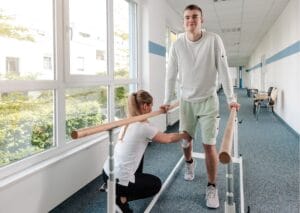Sports injuries can sideline even the most dedicated athletes, impacting not only their physical condition but also their mental state and future performance.
At our clinic, we frequently treat athletes ranging from recreational participants to those competing at an elite or university level. Through years of working with athletes, we’ve seen how physiotherapy plays a crucial role in both recovery and performance optimization. Let’s dive into the top five benefits of physiotherapy for sports injuries, and how it can help athletes return stronger, faster, and more resilient.
1. Accelerated Recovery and Return to Sport
One of the key benefits of physiotherapy is its ability to speed up recovery, allowing athletes to return to sport sooner and safer. Time off due to injury can have a significant impact on an athlete’s performance and mental well-being, and minimizing this downtime is often a top priority. Physiotherapy achieves this by creating individualized treatment plans that address the specific needs of the injury and the athlete’s goals.
For instance, a basketball player with a severe ankle sprain might initially receive manual therapy and joint mobilizations to reduce swelling and improve range of motion (Physiopedia, 2024c). Over time, this evolves into functional exercises that simulate the demands of their sport, like cutting and jumping. In cases like this, early intervention using techniques such as taping and myofascial release accelerates healing and allows athletes to get back to training and competition faster.
Physiotherapy also focuses on promoting tissue healing in the most effective way. By targeting the injury site with specific interventions like ultrasound, electrical stimulation, or dry needling, athletes can achieve better tissue repair. This tailored approach, designed around the athlete’s sport-specific needs, ensures that they recover not just quickly but fully.
2. Injury Prevention and Long-Term Athletic Health

Preventing re-injury is just as important as treating the initial injury, and this is where physiotherapy truly shines. A significant part of rehabilitation focuses on identifying and correcting the biomechanical issues that may have contributed to the injury. For athletes, this often means addressing underlying weaknesses, muscle imbalances, or improper movement patterns.
For example, during our work with university athletes, we’ve seen recurring hamstring strains often tied to weak gluteal muscles and poor core stability (Physiopedia, 2024d). After a thorough assessment, our physiotherapists develop a strengthening program aimed at ta
rgeting these areas, ultimately reducing the risk of future injuries. This preventative approach ensures that the body’s movement patterns are optimized, and athletes are less prone to injury as they continue to train and compete.
At the clinic, we emphasize not only short-term recovery but also long-term health. Our approach is proactive—through education, mobility work, and tailored strength programs, athletes are equipped with the tools they need to maintain their physical health for years to come. Injury prevention isn’t just about avoiding the next injury; it’s about creating a foundation for sustained athletic performance.
3. Effective Pain Management Without Medications
For athletes, pain is often an unfortunate reality, especially during injury recovery. However, many athletes are hesitant to rely on medications, particularly those that may affect their performance or carry the risk of addiction. Physiotherapy offers a wide range of natural, drug-free techniques to manage pain effectively, helping athletes recover without the need for painkillers.
At our clinic, treatments such as manual therapy and myofascial release are used to reduce pain and inflammation as well as restore movement (Physiopedia, 2024b; Physiopedia 2024e). Contemporary Medical Acupuncture, another highly effective method, is commonly applied to promote healing and manage pain. Acupuncture works by stimulating the body’s natural pain-relief mechanisms, releasing endorphins, and improving blood flow to the injured area.
We often see athletes with chronic pain conditions such as patellar tendonitis or rotator cuff tendinopathy. For example, a soccer player dealing with chronic knee pain might benefit from a combination of manual therapy and corrective exercises targeting muscle imbalances around the knee and hip. This approach allows the athlete to regain function and manage pain, avoiding the pitfalls of relying on medications like opioids.
4. Improved Mobility, Flexibility, and Function

Sports injuries often lead to reduced mobility and flexibility, both of which are critical for optimal performance. Physiotherapy plays a vital role in restoring full range of motion and flexibility in joints and muscles, ensuring athletes can return to their sport with no limitations.
Consider a swimmer recovering from a shoulder injury, such as a rotator cuff strain. Shoulder injuries often cause significant restrictions in range of motion, limiting overhead movements essential in swimming (Physiopedia, 2024f). Physiotherapists use joint mobilizations, stretching protocols, and functional exercises designed to restore full mobility in the shoulder. With a focus on regaining movement while avoiding compensatory patterns, athletes can prevent further injury and maximize their performance once back in the pool.
Flexibility and mobility are also critical for injury prevention. Through guided stretching, joint mobilizations, and dynamic movements tailored to the demands of each sport, physiotherapists help athletes improve flexibility, which enhances movement efficiency. Whether it’s a hockey player needing better hip mobility or a gymnast requiring full spinal range of motion, physiotherapy ensures athletes can perform at their best, unrestricted by tight or stiff muscles.
5. Customized Rehabilitation for Sport-Specific Needs

Every sport places different demands on the body, and physiotherapy tailors rehabilitation programs to meet the unique needs of each athlete and their specific sport. At our clinic, we’ve worked with patients from a wide range of disciplines – each requiring a highly individualized treatment plan.
For example, a track and field sprinter recovering from Achilles tendinopathy will need a rehabilitation program focused on calf strength, eccentric loading, and explosive power exercises to ensure the Achilles tendon can handle the demands of sprinting (Physiopedia, 2024a). This approach contrasts with a hockey player recovering from a shoulder injury, where the focus may be on rotator cuff stabilization, scapular control, and upper body strength to withstand the rigors of contact sport.
By customizing rehabilitation programs based on sport-specific movements, we ensure that the athlete’s recovery aligns with their performance goals. This not only speeds up the recovery process but also helps athletes return to their sport at peak condition, reducing the risk of re-injury and ensuring they feel confident in their return to competition.
Physiotherapy – A Key to Athletic Success
In the world of sports, injuries are an unfortunate reality. However, physiotherapy offers a comprehensive, science-backed approach to not only recover from injuries but to enhance performance and prevent future issues. At our clinic, we see firsthand how athletes and participants of recreational activities benefit from individualized care, tailored programs, and cutting-edge techniques that allow them to return to their sport stronger and more prepared than ever.
Whether you’re recovering from an injury or looking to enhance your performance, physiotherapy can provide the support and expertise needed to achieve your goals. Book with our physiotherapists for a personalized assessment and rehabilitation plan, and let’s work together to help you return to your sport at your best.
About the Author:
Sameenah Navsa
Bachelor’s of Kinesiology & Physical Education
References
Physiopedia. (2024a). Achilles tendinopathy. Physiopedia. https://www.physio-pedia.com/Achilles_Tendinopathy?utm_source=physiopedia&utm_medium=search&utm_campaign=ongoing_internal
Physiopedia. (2024b). Advanced myofascial release technique for chronic pain management. Physiopedia. https://www.physio-pedia.com/Advanced_Myofascial_Release_Technique_for_Chronic_Pain_Management?utm_source=physiopedia&utm_medium=search&utm_campaign=ongoing_internal
Physiopedia. (2024c). Ankle Sprain. Physiopedia. https://www.physio-pedia.com/Ankle_Sprain?utm_source=physiopedia&utm_medium=search&utm_campaign=ongoing_internal
Physiopedia. (2024d). Hamstring Strain. Physiopedia. https://www.physio-pedia.com/Hamstring_Strain?utm_source=physiopedia&utm_medium=search&utm_campaign=ongoing_internal
Physiopedia. (2024e). Manual Therapy. Physiopedia. https://www.physio-pedia.com/Manual_Therapy?utm_source=physiopedia&utm_medium=search&utm_campaign=ongoing_internal
Physiopedia. (2024f). Rotator cuff tears. Physiopedia. https://www.physio-pedia.com/Rotator_Cuff_Tears?utm_source=physiopedia&utm_medium=search&utm_campaign=ongoing_internal

